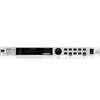Behringer FEEDBACK DESTROYER PRO DSP1124P Manual - Page 16
Editing filter parameters, Storing presets, Restoring the factory presets - manuale
 |
View all Behringer FEEDBACK DESTROYER PRO DSP1124P manuals
Add to My Manuals
Save this manual to your list of manuals |
Page 16 highlights
FEEDBACK DESTROYER PRO DSP1124P + To avoid inadvertent changing of filter modes, the filter mode selection takes place after about one second, which is indicated by a dot in the lower right corner of the DISPLAY. + Press the FILTER MODE and GAIN keys at the same time, and use the JOG WHEEL to adjust the feedback threshold (= feedback sensitivity) within a range from -3 to -9 dB. 7.3 Editing filter parameters + Remember: Your DSP1124P has ten pre-configured user presets, each comprising 12 filters per channel. Each individual filter can be selected in any of the four operating modes! + However, the “Locked” mode cannot be selected directly: when a filter which was selected as “Single-Shot” detects a feedback frequency, the filter is automatically set and “locked”, i.e. the filter is locked to the problem frequency and “keeps an eye” on it. + In Single-Shot and Auto modes, the filter parameter cannot be edited but only displayed. Editing can be done in Parametric EQ mode only: To change filter settings manually, the respective filter must be set to Parametric EQ mode. Press and keep the FILTER MODE key for about one second. Now, you can adapt the frequency after pressing FREQUENCY. Depending on the preset frequency, either the “Hz” or the “kHz” indicator to the right of the DISPLAY lights up. For example, when the filter is set to 160 Hz, the numeric DISPLAY will read the value and the “Hz” indicator lights up. To raise the frequency to 2,700 Hz, turn the JOG WHEEL clockwise until the ISO frequency (2.5 kHz; see Tab. 11.2) next to this value appears in the DISPLAY and the “kHz” indicator lights up. The FINE key allows you to fine tune the chosen standard ISO frequency within a tuning range of 1/3 octave (in 1/60-octave steps). The mathematical proportion between the displayed value and the absolute frequency, as well as a guide to find the desired frequency quickly, are listed in the appendix (chapter 11.1 – frequency chart). The bandwidth of the filter (quality) can be adjusted by selecting the BANDWIDTH key. The adjustable bandwidth ranges from 2 octaves down to 1/60 octave. By pressing the GAIN key, it is possible to set the desired boost or cut of the selected frequency. A “+” or “-” signals that the level is being increased or decreased respectively. + Filters in Single-Shot or Auto mode can be transformed into parametric filters with the same frequency, quality and 0 dB gain by pressing the FILTER MODE key for about one second. Only then will it be possible to edit the filter parameters. 7.4 Storing presets Whenever you edit a preset, the LED in the STORE key starts flashing. Basically, all edits in Parametric EQ mode and the filter deactivation in Off mode can be stored. Filters in Single-Shot or Auto mode adjust and store their parameters automatically. However, these data will get lost when you switch off the unit. To avoid that, please write the edited setting to a preset before you switch the DSP1124P off: Press the STORE key once, so that the DISPLAY starts flashing. If you wish to preserve the original preset, use the JOG WHEEL to select another preset number, which can be overwritten. Then, press STORE again to save your edits to the selected preset. If you wish to overwrite the original preset, simply press the STORE key twice after editing, so as to save all edits to the same preset. 7.5 Restoring the factory presets Press and keep the FILTER SELECT and STORE keys pressed before you switch on the FEEDBACK DESTROYER PRO. After power-up keep the switches pressed for another second. The preset numbers are counted up and the presets are reset to their original default values. 16 7. WORKING WITH PRESETS















